新版PEP小学五年级上册英语教案(全英)Unit5.A
- 格式:doc
- 大小:62.00 KB
- 文档页数:3
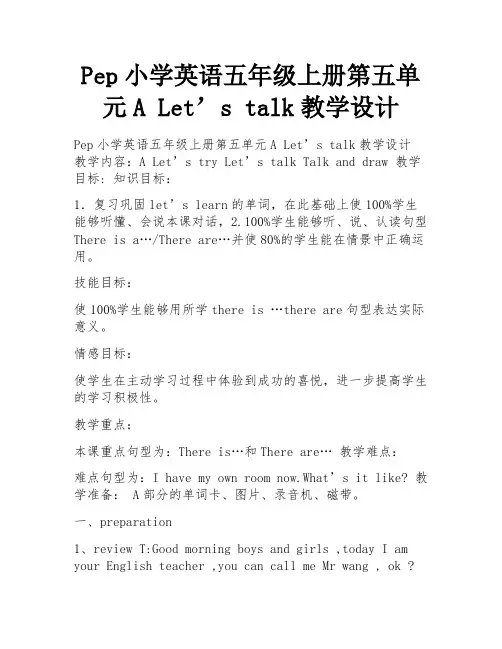
Pep小学英语五年级上册第五单元A Let’s talk教学设计Pep小学英语五年级上册第五单元A Let’s talk教学设计教学内容:A Let’s try Let’s talk Talk and draw 教学目标: 知识目标:1.复习巩固let’s learn的单词,在此基础上使100%学生能够听懂、会说本课对话,2.100%学生能够听、说、认读句型There is a…/There are…并使80%的学生能在情景中正确运用。
技能目标:使100%学生能够用所学there is …there are句型表达实际意义。
情感目标:使学生在主动学习过程中体验到成功的喜悦,进一步提高学生的学习积极性。
教学重点:本课重点句型为:There is…和There are… 教学难点:难点句型为:I have my own room now.What’s it like? 教学准备: A部分的单词卡、图片、录音机、磁带。
一、preparation1、review T:Good morning boys and girls ,today I am your English teacher ,you can call me Mr wang , ok ?S:Ok , S::You are so good!Can you remember this?(师拿单词相应的图片请生大声喊出它的英文名)T:Super , next let’s chant these words together ,are you ready ?2、Let’s chant.学生随着节奏边做边说:Closet,closet,open the closet!Curtain,curtain,close the curtain!Mirror,mirror,clean themirror!Trash bin,trash bin,empty the trashbin!End table,end table,move the end table!Air-conditioner,air-conditioner,make me cool!2、presentation Look, this is my own book penrulerroom,使学生充分领悟own的意思。
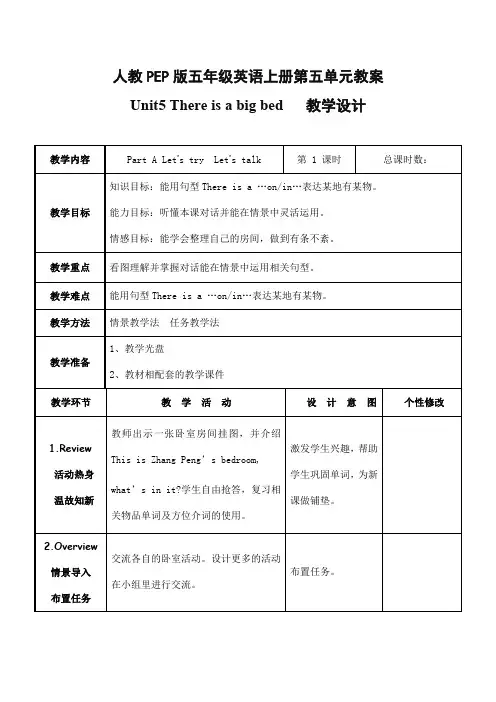
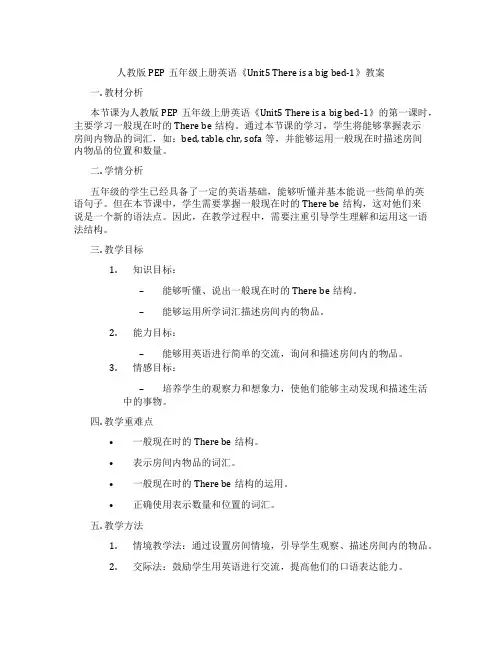
人教版PEP五年级上册英语《Unit5 There is a big bed-1》教案一. 教材分析本节课为人教版PEP五年级上册英语《Unit5 There is a big bed-1》的第一课时,主要学习一般现在时的There be结构。
通过本节课的学习,学生将能够掌握表示房间内物品的词汇,如:bed, table, chr, sofa等,并能够运用一般现在时描述房间内物品的位置和数量。
二. 学情分析五年级的学生已经具备了一定的英语基础,能够听懂并基本能说一些简单的英语句子。
但在本节课中,学生需要掌握一般现在时的There be结构,这对他们来说是一个新的语法点。
因此,在教学过程中,需要注重引导学生理解和运用这一语法结构。
三. 教学目标1.知识目标:–能够听懂、说出一般现在时的There be结构。
–能够运用所学词汇描述房间内的物品。
2.能力目标:–能够用英语进行简单的交流,询问和描述房间内的物品。
3.情感目标:–培养学生的观察力和想象力,使他们能够主动发现和描述生活中的事物。
四. 教学重难点•一般现在时的There be结构。
•表示房间内物品的词汇。
•一般现在时的There be结构的运用。
•正确使用表示数量和位置的词汇。
五. 教学方法1.情境教学法:通过设置房间情境,引导学生观察、描述房间内的物品。
2.交际法:鼓励学生用英语进行交流,提高他们的口语表达能力。
3.任务型教学法:通过完成小组任务,培养学生合作学习的能力。
六. 教学准备1.教师准备:–教材、课件、实物图片等教学资源。
–教室内的家具和物品,如:床、桌子、椅子等。
2.学生准备:–预习本节课的生词和句子。
–准备好一本英语本,用于记录课堂笔记。
七. 教学过程1.导入(5分钟)–教师通过提问学生熟悉的房间内的物品,引导学生进入本节课的主题。
–利用多媒体展示不同房间的图片,让学生猜测房间内的物品。
2.呈现(10分钟)–教师通过展示实物和图片,呈现本节课的主要词汇和句子。
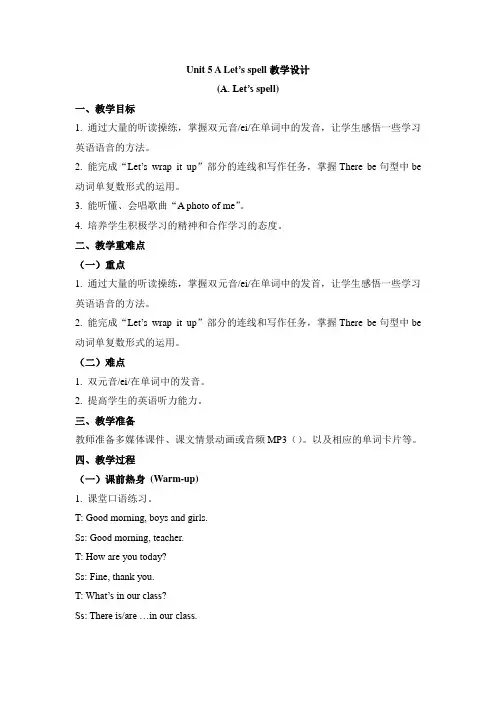
Unit 5 A Let’s spell教学设计(A. Let’s spell)一、教学目标1. 通过大量的听读操练,掌握双元音/ei/在单词中的发音,让学生感悟一些学习英语语音的方法。
2. 能完成“Let’s wrap it up”部分的连线和写作任务,掌握There be句型中be 动词单复数形式的运用。
3. 能听懂、会唱歌曲“A photo of me”。
4. 培养学生积极学习的精神和合作学习的态度。
二、教学重难点(一)重点1. 通过大量的听读操练,掌握双元音/ei/在单词中的发首,让学生感悟一些学习英语语音的方法。
2. 能完成“Let’s wrap it up”部分的连线和写作任务,掌握There be句型中be 动词单复数形式的运用。
(二)难点1. 双元音/ei/在单词中的发音。
2. 提高学生的英语听力能力。
三、教学准备教师准备多媒体课件、课文情景动画或音频MP3()。
以及相应的单词卡片等。
四、教学过程(一)课前热身(Warm-up)1. 课堂口语练习。
T: Good morning, boys and girls.Ss: Good morning, teacher.T: How are you today?Ss: Fine, thank you.T: What’s in our class?Ss: There is/are …in our class.2. 请两三对学生上讲台表演“Let’s wrap it up”部分的对话。
(二)课前预习(Preview)1. 唱歌曲。
(1) 播放两遍歌曲“A photo of me”的录音,全班学生大声跟着录音唱。
(2) 第二次播放录音,全班学生分组比赛唱歌曲。
2. 教师出示一个房间图,学生用“There be”句型说说房间内有什么。
3. 学生同桌玩“剪刀、石头、布游戏”,赢的一方问:“Wha t’s in the room?”输的一方用句型“There is/are... in the room.”回答。
![[最新]pep五年级英语上册Unit 5 Part A 第二课时-优质教案.doc](https://uimg.taocdn.com/4e2e6d44c5da50e2524d7fd7.webp)
1.能听、说、读、写单词clock,plant,photo,water bottle,bike,并能用句型“There is …”表达某处有某物。
2.能做Let’s play部分的游戏。
3.培养学生热爱自己家的情感。
4.培养学生英语口语表达能力,培养小组同学间的合作意识。
1.能听、说、读、写单词clock, bike, photo, water bottle, plant。
2.能用句型“There is …”表达某处有某物。
3.能做Let’s play的游戏。
There be 句型的灵活运用。
课件,单词卡片,教学光盘。
Step 1:Warm up教师情景导入,T:大家知道怎么向别人介绍东西吗?Ss: This is …T:Good!今天我们要向别人介绍自己的房间,让我们先一起去看看Zhang Peng的房间。
Step 2: Presentation1.教师利用多媒体用课件展示图片clock。
展示曾经学过的单词时学生需快速反应出来,然后展示其它图片:door, computer, chair, desk, bed, window,教师和学生互动:“房间还少了什么东西”,同学回答:“p h o t o”。
引出单词之后,教师教读,出示单词卡片,学生跟读。
2.分组比赛,读新学单词,然后找学生示范朗读。
3.听录音,看看张鹏怎样介绍自己的房间的。
This is my room. There is a clock,a …引出“there is”有。
4.教师出示单词卡片,学生开火车用there is …in my room说句子。
Step 3:Consolidation and extension1.五人一组,小组接龙大比赛。
第一个人说:“There is a clock in my room.”第二个人就要加一样物品,第三个人要说三样……依次类推,比比哪个组说得最流畅。
2.每个人都有自己的家,大家都爱自己的家,有了家我们才能体会到温暖和爱,请同学们自己绘出自己的家或者用英语描述自己的家。
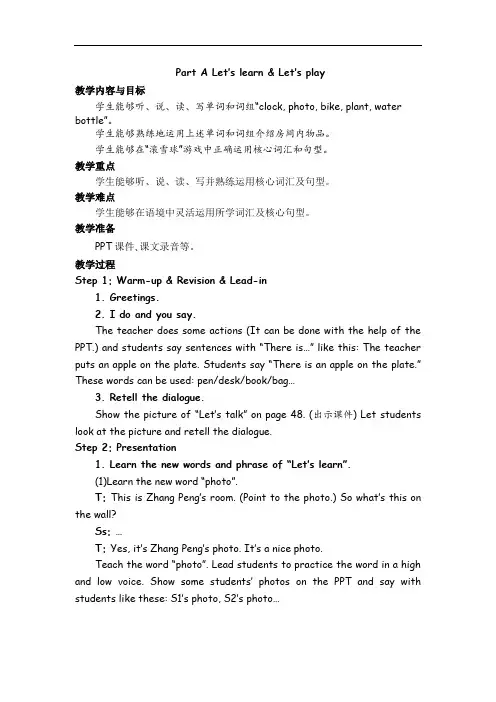
Part A Let’s learn & Let’s play教学内容与目标学生能够听、说、读、写单词和词组“clock, photo, bike, plant, water bottle”。
学生能够熟练地运用上述单词和词组介绍房间内物品。
学生能够在“滚雪球”游戏中正确运用核心词汇和句型。
教学重点学生能够听、说、读、写并熟练运用核心词汇及句型。
教学难点学生能够在语境中灵活运用所学词汇及核心句型。
教学准备PPT课件、课文录音等。
教学过程Step 1: Warm-up & Revision & Lead-in1. Greetings.2. I do and you say.The teacher does some actions (It can be done with the help of the PPT.) and students say sentences with “There is…” like this: The teacher puts an apple on the plate. Students say “There is an apple on the plate.” These words can be used: pen/desk/book/bag…3. Retell the dialogue.Show the picture of “Let’s talk” on page 48. (出示课件) Let students look at the picture and retell the dialogue.Step 2: Presentation1. Learn the new words and phrase of “Let’s learn”.(1)Learn the new word “photo”.T: This is Zhang Peng’s room. (Point to the photo.) So what’s this on the wall?Ss: …T: Yes, it’s Zhang Peng’s photo. It’s a nice photo.Teach the word “photo”. Lead students to practice the word in a high and low voice. Show some students’ photos on the PPT and say with students like these: S1’s photo, S2’s photo…Write down the word “photo” on the blackboard. Ask students to pay attention to the sound of the letter “o”. Ask students to fill in the blanks: _ _ oto, ph_t_, pho_o.Lead students to practice the sentence patterns “There is a nice/beautiful/funny/cool/…photo in/on…” in groups.Show a picture and a photo to students. (出示课件)T: Look! This is a picture. I can draw a picture. (with the action of“drawing”). This is a photo. It’s Zhang Peng’s photo.Explain the difference between the two words. Lead students to practice with “There is a picture/photo in/on…”(2)Learn the new word “clock”.T: Zhang Peng is a student. He is never late for school, because the clock helps him a lot. (课件出示:先出现张鹏房间图片,后聚焦在clock上面) T: Look! This is Zhang Peng’s clock.Teach the word “clock”. Lead students to practice the word in a high and low voice. Write it down on the blackboard. Ask students to pay attention to the sound of the letter “o”. Ask students to fill in the blanks: cl_ck, clo_ _ , c_o_ _ .Show various clocks. (出示课件) Let students practice the sentence patterns “There is a funny/yellow…clock in Zhang Peng’s room.”(3)Learn the new word “bike”.T: Zhang Peng goes to school by bike. (Point to the bike.) Look, this is his bike. It’s near the door.Teach the word “bike” like this: i-/aɪ/, bike. Show the word “like” to help students read and remember the word “bike”. Lead students to practice it in a high and low voice.Write it down on the blackboard. Ask students to fill in the blanks: b_k_, _i_e.Show several bikes in different colours (red bike, blue bike…) on the PPT. (出示课件)Lead students to practice the sentence pattern “There is a red/…bike near/behind…”(4)Learn the new word “plant”.Show a picture on the PPT. (课件出示:一个男孩骑车上学,路边有一些植物)T: Look! The boy is riding a bike. (Point to a plant along the road.) What’s this?Help students answer: Plant.Teach the word “plant”. Lead students to practice the word in a high and low voice. Write it down on the blackboard. Ask students to pay attention to the sound of the letter “a”. Ask students to fill in the blanks: pl_nt, p_ant, pla_t.Lead students to practice the sentences “There is a plant./There are some plants.” one by one with some different pictures. (出示课件)At last the teacher asks: Does Zhang Peng like plants? Guess! After students guess, the teacher says: Yes. Zhang Peng likes plants. Look, there is a plant near the window in his room. And many plants can make the air fresh for us.(5)Learn the new phrase “water bottle”.T: Zhang Peng rides a bike to school every day. He’s often thirsty. So he always takes a water bottle in his bag.Teach the word “bottle”. Give the words “little, apple” to help students read and remember the word. Lead students to practice it in a high and low voice. Write down the phrase “water bottle” on the blackboard. Ask students to fill in the blanks: b_tt_e, bot_le, bo_ _le.Show some pictures and lead students to practice the phrase “water bottle, milk bo ttle” and the sentence “There is a water bottle in his bag.” (出示课件)2. Read and act.The teacher plays the recording. (出示课件) Students read after it one by one. After practicing in different ways, students try to say sentences in class like these: This is m y room. There is a clock, a… Ask students to pay attention to the position of the word “and”.Step 3: Practice1. Say in different voices.The teacher says a word in a low voice, and students say it in a high voice. The teacher says a word in a high voice, and students say it in a low voice. Practice the new words and the phrase.2. Listen and choose.The teacher says a word. Students choose the corresponding picture from the three pictures that appear at random on the PPT. (出示课件)3. What’s missing?Divide the new words and phrase into five groups. There are three words in every group. Show the groups of words on the PPT. Let students say what’s missing quickly. (出示课件)Step 4: Consolidation & Extension1. Let’s play.Show the picture and the sentences of “Let’s play” on page 49 on the PPT.(出示课件) Let students find the difference among the three sentences. Students imitate and work in groups. The teacher shows some sentences on the PPT to help students. Choose some students to show in class like these: There is a bike in my room. There is a bike and a computer in my room. There is a bike, a computer and a photo in my room.2. Listen, draw and say.Tell students what’s in the room and students draw the corresponding room. Then some students introduce the room with the sentence patterns “There is a…in the room. There is a…and a…in the room.” The others check the answers with the teacher.3. Write and say.Show a picture of a room and a passage with some blanks on the PPT. (出示课件) Ask students to finish the passage according to the information. Then let several students stand up and read their passages. The following passage can be used:This is my room. There is a ________ in my room. There is a ________. There is a ________ and a ________, too. I like my room very much. It’s clean and nice.Encourage students to introduce their own rooms. These words and phrases can be used: end table, closet, mirror, curtain, trash bin, air-conditioner, heating system…板书作业1. Listen to the recording of “Let’s learn” and rea d after it.2. Introduce your room to your parents.教学反思采用对比、自然拼读等多种方法教授单词;以学生为本,设计了丰富多样的操练活动,从音、义、形几个方面由浅入深地进行操练;学生在学中玩、玩中学,活跃了课堂气氛;注重学习方法和学习策略的培养,从根本上指导学生听、说、读、写单词。
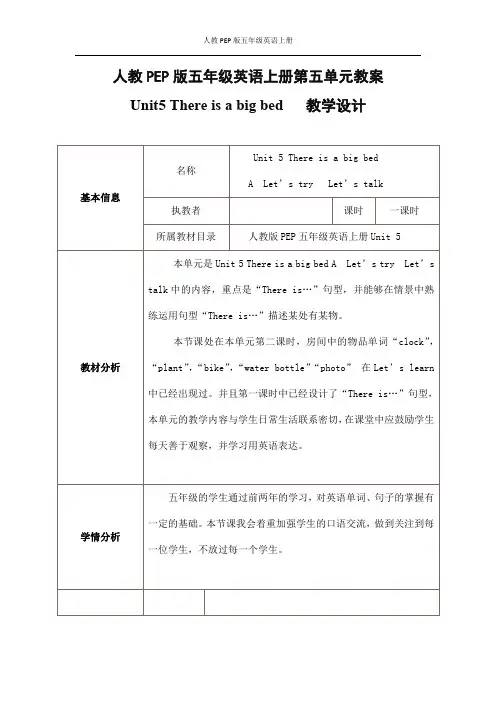
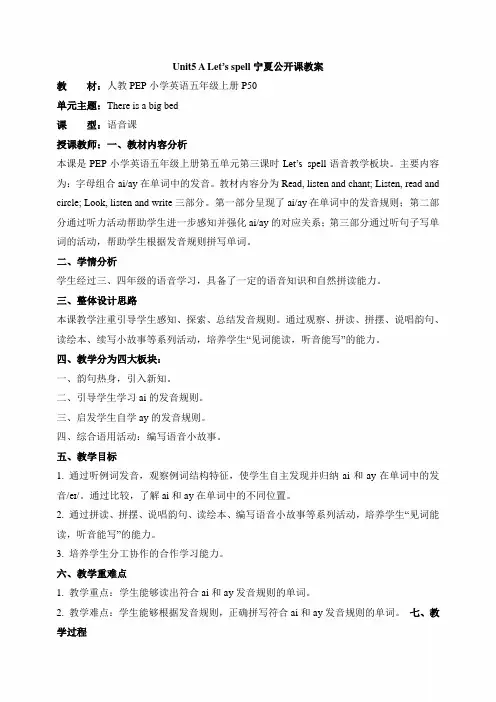
Unit5 A Let’s spell宁夏公开课教案教材:人教PEP小学英语五年级上册P50单元主题:There is a big bed课型:语音课授课教师:一、教材内容分析本课是PEP小学英语五年级上册第五单元第三课时Let’s spell语音教学板块。
主要内容为:字母组合ai/ay在单词中的发音。
教材内容分为Read, listen and chant; Listen, read and circle; Look, listen and write三部分。
第一部分呈现了ai/ay在单词中的发音规则;第二部分通过听力活动帮助学生进一步感知并强化ai/ay的对应关系;第三部分通过听句子写单词的活动,帮助学生根据发音规则拼写单词。
二、学情分析学生经过三、四年级的语音学习,具备了一定的语音知识和自然拼读能力。
三、整体设计思路本课教学注重引导学生感知、探索、总结发音规则。
通过观察、拼读、拼摆、说唱韵句、读绘本、续写小故事等系列活动,培养学生“见词能读,听音能写”的能力。
四、教学分为四大板块:一、韵句热身,引入新知。
二、引导学生学习ai的发音规则。
三、启发学生自学ay的发音规则。
四、综合语用活动:编写语音小故事。
五、教学目标1. 通过听例词发音,观察例词结构特征,使学生自主发现并归纳ai和ay在单词中的发音/eɪ/。
通过比较,了解ai和ay在单词中的不同位置。
2. 通过拼读、拼摆、说唱韵句、读绘本、编写语音小故事等系列活动,培养学生“见词能读,听音能写”的能力。
3. 培养学生分工协作的合作学习能力。
六、教学重难点1. 教学重点:学生能够读出符合ai和ay发音规则的单词。
2. 教学难点:学生能够根据发音规则,正确拼写符合ai和ay发音规则的单词。
七、教学过程Step1: Warm-up1. Greetings & Evaluations.师生互致问候,告知学生本课从看、听、说、写四方面综合评价,展开小组竞赛。
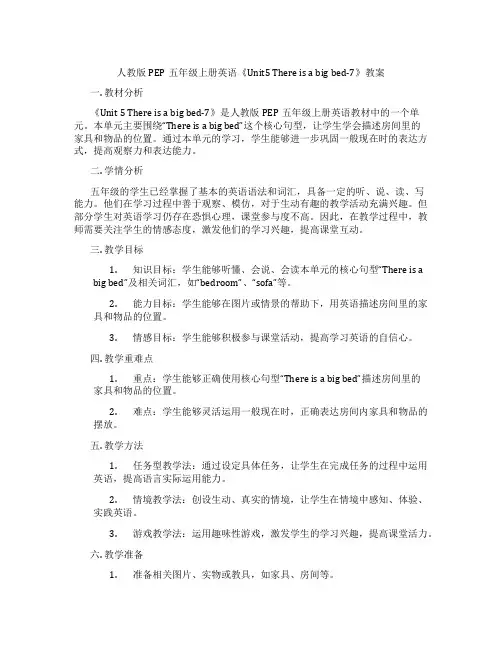
人教版PEP五年级上册英语《Unit5 There is a big bed-7》教案一. 教材分析《Unit 5 There is a big bed-7》是人教版PEP五年级上册英语教材中的一个单元。
本单元主要围绕“There is a big bed”这个核心句型,让学生学会描述房间里的家具和物品的位置。
通过本单元的学习,学生能够进一步巩固一般现在时的表达方式,提高观察力和表达能力。
二. 学情分析五年级的学生已经掌握了基本的英语语法和词汇,具备一定的听、说、读、写能力。
他们在学习过程中善于观察、模仿,对于生动有趣的教学活动充满兴趣。
但部分学生对英语学习仍存在恐惧心理,课堂参与度不高。
因此,在教学过程中,教师需要关注学生的情感态度,激发他们的学习兴趣,提高课堂互动。
三. 教学目标1.知识目标:学生能够听懂、会说、会读本单元的核心句型“There is abig bed”及相关词汇,如“bedroom”、“sofa”等。
2.能力目标:学生能够在图片或情景的帮助下,用英语描述房间里的家具和物品的位置。
3.情感目标:学生能够积极参与课堂活动,提高学习英语的自信心。
四. 教学重难点1.重点:学生能够正确使用核心句型“There is a big bed”描述房间里的家具和物品的位置。
2.难点:学生能够灵活运用一般现在时,正确表达房间内家具和物品的摆放。
五. 教学方法1.任务型教学法:通过设定具体任务,让学生在完成任务的过程中运用英语,提高语言实际运用能力。
2.情境教学法:创设生动、真实的情境,让学生在情境中感知、体验、实践英语。
3.游戏教学法:运用趣味性游戏,激发学生的学习兴趣,提高课堂活力。
六. 教学准备1.准备相关图片、实物或教具,如家具、房间等。
2.制作课件,展示本节课的核心句型和词汇。
3.准备课堂活动用的游戏道具。
七. 教学过程1.导入(5分钟)利用歌曲、游戏等趣味性活动,引导学生进入英语学习氛围。
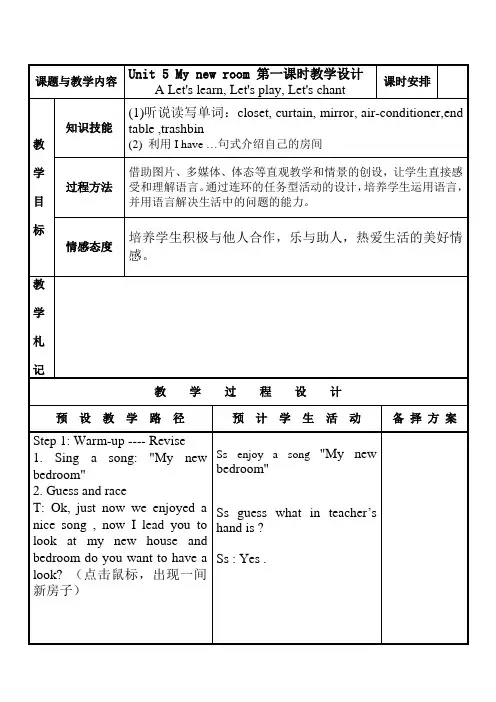
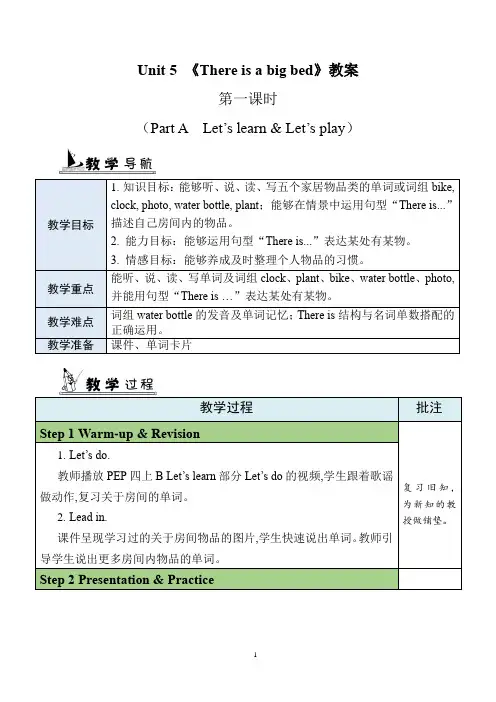
Unit 5 There is a big bedPart ALet’s learn & Let’s play【教学目标】1. 能听、说、读、写名词性物主代词mine、yours、his、hers、theirs、ours,并能在句中灵活运用。
2. 能区分形容词性物主代词和名词性物主代词,即:名词性物主代词=形容词性物主代词+名词。
3. 能运用名词性物主代词写出同义句,eg: It’s your dog The dog is yours.【教学重难点】重点:能听、说、读、写名词性物主代词mine、yours、his、hers、theirs、ours。
难点:1. 能在语境、合作、交流中体会并理解物主代词的用法,掌握句子:Whose dog is it ? It’s your dog .The dog is yours.2. 能正确区分形容词性物主代词和名词性物主代词的不同。
【课前准备】1. 单词卡片/小狗的图片;2. 教学光盘或其他录音机设备;3. 教学课件。
【教学过程】Step 1:Warm-up1. 学生欣赏Unit 5中的歌曲。
2. 教师出示歌曲中提及的动物图片,然后抢答。
3. 活动:智力大比拼。
活动方式:教师叫四名学生带上自己的钢笔到讲台上来并举起自己的钢笔介绍:“It’s my pen.”。
然后教师让这几名学生背对大家,互相交换手中的钢笔,并迅速交换所站的位置。
然后请其中一个凭自己的记忆猜测钢笔的所属。
如:This is his pen. This is her pen. This is my pen. This is your pen.等。
Step 2: Presentation1. Let’s learn.(1)学习单词his和hers。
课件出示Let’s learn部分的画面,教师指着第一只狗说:Look! This is his dog. It’s his. That’s her dog. Lt’s hers.然后出示单词卡片his和hers,并请全班跟读。
人教版PEP五年级上册英语《Unit5 There is a big bed-5》教学设计一. 教材分析《Unit 5 There is a big bed-5》是人教版PEP五年级上册英语教材的一部分,主要围绕着家居环境和学习英语动词短语的主题展开。
通过本单元的学习,学生能够进一步掌握there be句型,以及一些描述家居物品的词汇和动词短语。
教材通过丰富的图片和生动的场景,激发学生的学习兴趣,培养他们的观察能力和语言表达能力。
二. 学情分析五年级的学生已经具备了一定的英语基础,能够听、说、读、写一些简单的英语句子。
他们在学习过程中积极向上,乐于参与各种课堂活动。
但对于一些复杂的句子结构和动词短语的运用,学生可能还存在一定的困难。
因此,在教学过程中,教师需要关注学生的个体差异,给予不同程度的学生适当的指导和帮助。
三. 教学目标1.知识目标:学生能够听、说、读、写有关家居环境的词汇和动词短语,如bed, table, chr, desk, there be等。
2.能力目标:学生能够在真实情境中运用所学知识进行交流,提高他们的语言表达能力。
3.情感目标:培养学生热爱生活、关注家居环境的良好情感态度。
四. 教学重难点1.重点:掌握有关家居环境的词汇和动词短语,能够用there be句型进行描述。
2.难点:正确运用动词短语和there be句型进行实际交流。
五. 教学方法1.情境教学法:通过设置真实的家居环境情境,引导学生参与课堂活动,激发学生的学习兴趣。
2.交际法:采用生生互动、师生互动的方式,让学生在实际交流中运用所学知识。
3.任务型教学法:设计各种任务,让学生在完成任务的过程中,提高自己的语言能力。
六. 教学准备1.教学课件:制作与教材内容相关的课件,包括图片、动画、视频等。
2.教学道具:准备一些家居物品的模型或图片,如床、桌子、椅子等。
3.练习题:设计一些有关本节课内容的练习题,用于巩固所学知识。
1.能听、说、认、读单词“there”。
2.能灵活运用“There be”句型介绍房间内有什么,并用适当的形容词,如:big, small, nice, pretty等词来描述房间内的物体。
3.能完成Let’s try部分的听力任务。
4.激发学生与他人进行合作交流的兴趣,培养学生合作意识。
1.能听、说、认、读单词“there”。
2.能灵活运用“There be”句型介绍房间内有什么,并用适当的形容词描述房间内的物体。
There be句型在日常交际用语里的灵活运用。
单词卡片,教学光盘,人物头饰。
Step 1:Warm up出示四张图片,教师描述自己的房间,这四副图中有一副图是教师自己的,学生根据描述,选出教师的房间。
eg: There is a clock near the photo. There is a bed in the room.学生根据关键词选出图片。
Step 2: Presentation1.Sarah and Mike are in the Zhang Peng’s room. They are talking about Zhang Peng’s room.听听力,思考:(1)What’s in the Zhang Peng’s room?(2)Is Zhang Peng’s room nice?(3)Where is the computer?2.学生听第一遍时,跟读对话,模仿语音、语调。
学生听第二遍之后,回答问题:(1)There is a big bed, a nice photo and a computer.(2)Yes, it is.(3)It’s on the desk.学生听第三遍时,模仿对话操练,并解释对话的基本意思。
3.三人一组,相互练习对话,也可以自设情景,带上人物头饰,表演Let’s talk部分对话。
比一比,哪组表演得最优秀。
4.教师出示图片,要求学生用There be 句型描述房间里有哪些物体。